跨域請求資源的幾種方式,具體如下:
1.什麼是跨域
2.JSONP
3.proxy代理
4.cors
5.xdr
由於浏覽器同源策略,凡是發送請求url的協議、域名、端口三者之間任意一與當前頁面地址不同即為跨域。具體可以查看下表
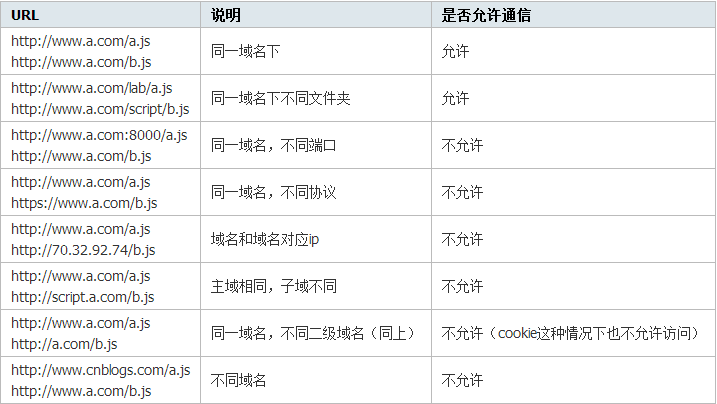
JSONP
這種方式主要是通過動態插入一個script標簽。浏覽器對script的資源引用沒有同源限制,同時資源加載到頁面後會立即執行(沒有阻塞的情況下)。
<script>
var _script = document.createElement('script');
_script.type = "text/javascript";
_script.src = "http://localhost:8888/jsonp?callback=f";
document.head.appendChild(_script);
</script>
實際項目中JSONP通常用來獲取json格式數據,這時前後端通常約定一個參數callback,該參數的值,就是處理返回數據的函數名稱。
<!doctype html>
<html>
<head>
<meta charset="utf-8">
<meta name="viewport" content="initial-scale=1, maximum-scale=1,user-scalable=no">
<title>jsonp_test</title>
<script>
var f = function(data){
alert(data.name);
}
/*var xhr = new XMLHttpRequest();
xhr.onload = function(){
alert(xhr.responseText);
};
xhr.open('POST', 'http://localhost:8888/cors', true);
xhr.setRequestHeader("Content-Type", "application/x-www-form-urlencoded");
xhr.send("f=json");*/
</script>
<script>
var _script = document.createElement('script');
_script.type = "text/javascript";
_script.src = "http://localhost:8888/jsonp?callback=f";
document.head.appendChild(_script);
</script>
</head>
var query = _url.query;
console.log(query);
var params = qs.parse(query);
console.log(params);
var f = "";
f = params.callback;
res.writeHead(200, {"Content-Type": "text/javascript"});
res.write(f + "({name:'hello world'})");
res.end();

缺點:
1、這種方式無法發送post請求(這裡)
2、另外要確定jsonp的請求是否失敗並不容易,大多數框架的實現都是結合超時時間來判定。
Proxy代理
這種方式首先將請求發送給後台服務器,通過服務器來發送請求,然後將請求的結果傳遞給前端。
<!doctype html>
<html>
<head>
<meta charset="utf-8">
<meta name="viewport" content="initial-scale=1, maximum-scale=1,user-scalable=no">
<title>proxy_test</title>
<script>
var f = function(data){
alert(data.name);
}
var xhr = new XMLHttpRequest();
xhr.onload = function(){
alert(xhr.responseText);
};
xhr.open('POST', 'http://localhost:8888/proxy?http://geocode.arcgis.com/arcgis/rest/services/World/GeocodeServer', true);
xhr.send("f=json");
</script>
</head>
<body>
</body>
</html>
var proxyUrl = "";
if (req.url.indexOf('?') > -1) {
proxyUrl = req.url.substr(req.url.indexOf('?') + 1);
console.log(proxyUrl);
}
if (req.method === 'GET') {
request.get(proxyUrl).pipe(res);
} else if (req.method === 'POST') {
var post = ''; //定義了一個post變量,用於暫存請求體的信息
req.on('data', function(chunk){ //通過req的data事件監聽函數,每當接受到請求體的數據,就累加到post變量中
post += chunk;
});
req.on('end', function(){ //在end事件觸發後,通過querystring.parse將post解析為真正的POST請求格式,然後向客戶端返回。
post = qs.parse(post);
request({
method: 'POST',
url: proxyUrl,
form: post
}).pipe(res);
});
}

需要注意的是如果你代理的是https協議的請求,那麼你的proxy首先需要信任該證書(尤其是自定義證書)或者忽略證書檢查,否則你的請求無法成功。12306就提供了一個鮮活的例子。
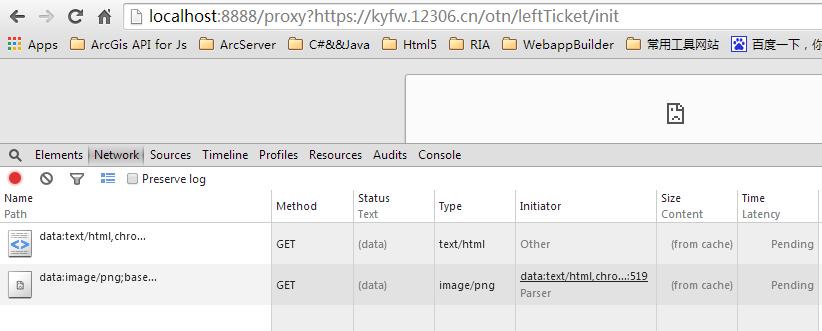
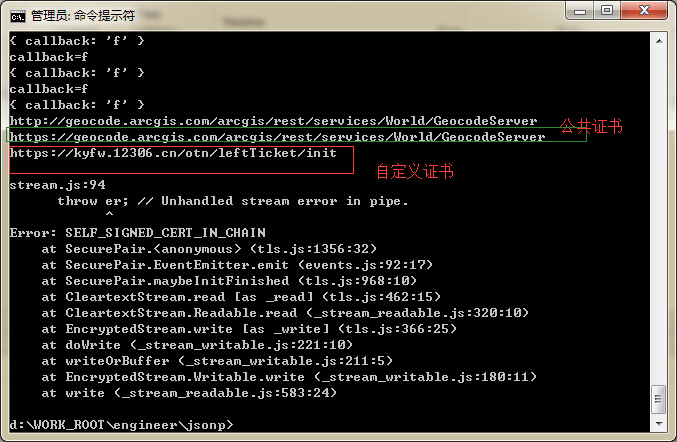
還需要注意一點,對於同一請求浏覽器通常會從緩存中讀取數據,我們有時候不想從緩存中讀取,所以會加一個preventCache參數,這個時候請求url變成:url?preventCache=12345567....;這本身沒有什麼問題,問題出在當使用某些前端框架(比如jquery)發送proxy代理請求時,請求url為proxy?url,同時設置preventCache:true,框架不能正確處理這個參數,結果發出去的請求變成proxy?url&preventCache=123456(正長應為proxy?url?preventCache=12356);後端截取後發送的請求為url&preventCache=123456,根本沒有這個地址,所以你得不到正確結果。
CORS
這是現代浏覽器支持跨域資源請求的一種方式。
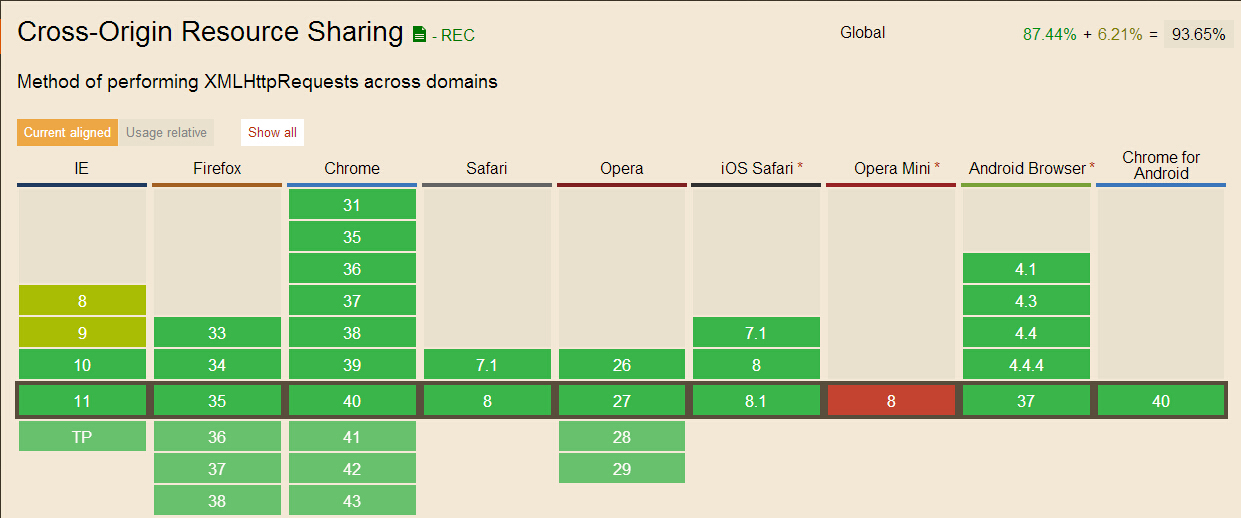
當你使用XMLHttpRequest發送請求時,浏覽器發現該請求不符合同源策略,會給該請求加一個請求頭:Origin,後台進行一系列處理,如果確定接受請求則在返回結果中加入一個響應頭:Access-Control-Allow-Origin;浏覽器判斷該相應頭中是否包含Origin的值,如果有則浏覽器會處理響應,我們就可以拿到響應數據,如果不包含浏覽器直接駁回,這時我們無法拿到響應數據。
<!doctype html>
<html>
<head>
<meta charset="utf-8">
<meta name="viewport" content="initial-scale=1, maximum-scale=1,user-scalable=no">
<title>jsonp_test</title>
<script>
/*var f = function(data){
alert(data.name);
}*/
var xhr = new XMLHttpRequest();
xhr.onload = function(){
alert(xhr.responseText);
};
xhr.open('POST', 'http://localhost:8888/cors', true);
xhr.setRequestHeader("Content-Type", "application/x-www-form-urlencoded");
xhr.send("f=json");
</script>
<script>
/* var _script = document.createElement('script');
_script.type = "text/javascript";
_script.src = "http://localhost:8888/jsonp?callback=f";
document.head.appendChild(_script);*/
</script>
</head>
<body>
</body>
</html>
前端cors
if (req.headers.origin) {
res.writeHead(200, {
"Content-Type": "text/html; charset=UTF-8",
"Access-Control-Allow-Origin":'http://localhost'/*,
'Access-Control-Allow-Methods': 'GET, POST, OPTIONS',
'Access-Control-Allow-Headers': 'X-Requested-With, Content-Type'*/
});
res.write('cors');
res.end();
}
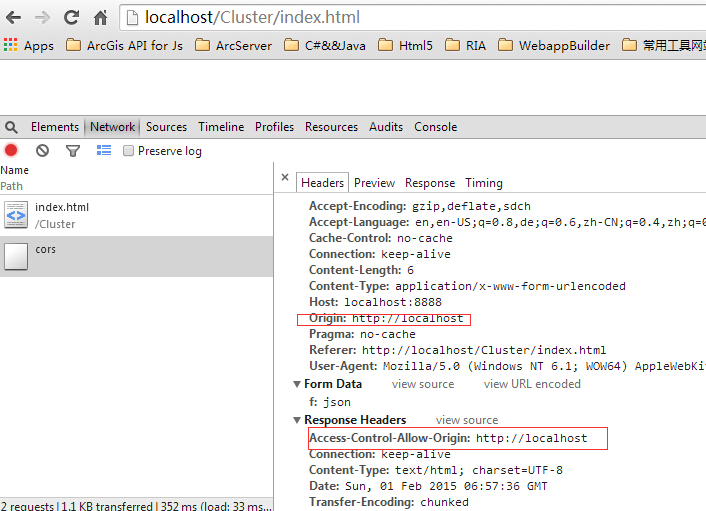
如果我們把Access-Control-Allow-Origin去掉,浏覽器會駁回響應,我們也就拿不到數據。
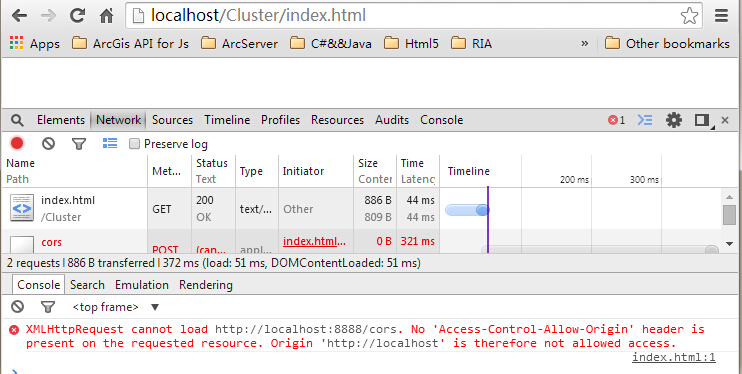
需要注意的一點是Preflighted Request的透明服務器驗證機制支持開發人員使用自定義的頭部、GET或POST之外的方法,以及不同類型的主題內容。總結如如:
1、非GET 、POST請求
2、POST請求的content-type不是常規的三個:application/x- www-form-urlencoded(使用 HTTP 的 POST 方法提交的表單)、multipart/form-data(同上,但主要用於表單提交時伴隨文件上傳的場合)、text/plain(純文本)
3、POST請求的payload為text/html
4、設置自定義頭部
OPTIONS請求頭部中會包含以下頭部:Origin、Access-Control-Request-Method、Access-Control-Request-Headers,發送這個請求後,服務器可以設置如下頭部與浏覽器溝通來判斷是否允許這個請求。
Access-Control-Allow-Origin、Access-Control-Allow-Method、Access-Control-Allow-Headers
var xhr = new XMLHttpRequest();
xhr.onload = function(){
alert(xhr.responseText);
};
xhr.open('POST', 'http://localhost:8888/cors', true);
xhr.setRequestHeader("Content-Type", "text/html");
xhr.send("f=json");
if (req.headers.origin) {
res.writeHead(200, {
"Content-Type": "text/html; charset=UTF-8",
"Access-Control-Allow-Origin":'http://localhost',
'Access-Control-Allow-Methods': 'GET,POST,OPTIONS',
'Access-Control-Allow-Headers': 'X-Requested-With, Content-Type'/**/
});
res.write('cors');
res.end();
}
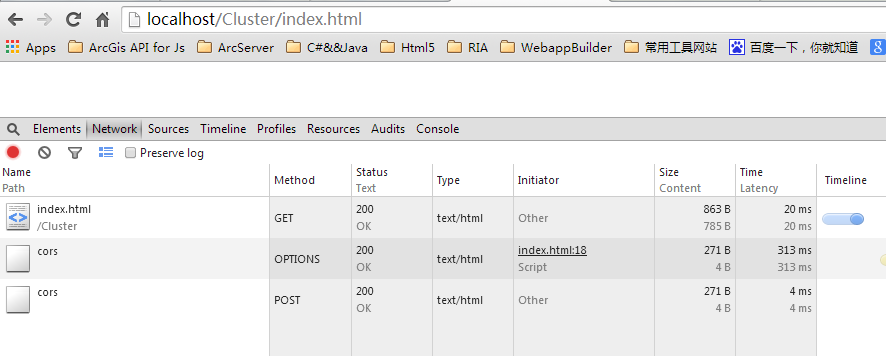
如果你在調試狀態,你會發現後台代碼執行了兩遍,說明發送了兩次請求。注意一下我們的onload代碼只執行了一次,所以說OPTIONS請求對程序來說是透明的,他的請求結果會被緩存起來。
如果我們修改一下後台代碼,把Content-Type去掉,你會發現OPTIONS請求失敗。


通過setRequestHeader('X-Request-With', null)可以避免浏覽器發送OPTIONS請求。
根據我的測試,當使用cors發送跨域請求時失敗時,後台是接收到了這次請求,後台可能也執行了數據查詢操作,只是響應頭部不合符要求,浏覽器阻斷了這次請求。
XDR
這是IE8、IE9提供的一種跨域解決方案,功能較弱只支持get跟post請求,而且對於協議不同的跨域是無能為力的,比如在http協議下發送https請求。看一下微軟自己的例子就行
<!DOCTYPE html>
<html>
<body>
<h2>XDomainRequest</h2>
<input type="text" id="tbURL" value="http://www.contoso.com/xdr.txt" style="width: 300px"><br>
<input type="text" id="tbTO" value="10000"><br>
<input type="button" onclick="mytest()" value="Get">
<input type="button" onclick="stopdata()" value="Stop">
<input type="button" onclick="readdata()" value="Read">
<br>
<div id="dResponse"></div>
<script>
var xdr;
function readdata()
{
var dRes = document.getElementById('dResponse');
dRes.innerText = xdr.responseText;
alert("Content-type: " + xdr.contentType);
alert("Length: " + xdr.responseText.length);
}
function err()
{
alert("XDR onerror");
}
function timeo()
{
alert("XDR ontimeout");
}
function loadd()
{
alert("XDR onload");
alert("Got: " + xdr.responseText);
}
function progres()
{
alert("XDR onprogress");
alert("Got: " + xdr.responseText);
}
function stopdata()
{
xdr.abort();
}
function mytest()
{
var url = document.getElementById('tbURL');
var timeout = document.getElementById('tbTO');
if (window.XDomainRequest)
{
xdr = new XDomainRequest();
if (xdr)
{
xdr.onerror = err;
xdr.ontimeout = timeo;
xdr.onprogress = progres;
xdr.onload = loadd;
xdr.timeout = tbTO.value;
xdr.open("get", tbURL.value);
xdr.send();
}
else
{
alert("Failed to create");
}
}
else
{
alert("XDR doesn't exist");
}
}
</script>
</body>
</html>
以上就是我在實際項目中遇到的跨域請求資源的情況,有一種跨域需要特別注意就是在https協議下發送https請求,除了使用proxy代理外其他方法都無解,會被浏覽器直接block掉。如果哪位道友知道解決方法,麻煩你告訴我一聲。
最後附上完整的測試demo
iss中:
<!doctype html>
<html>
<head>
<meta charset="utf-8">
<meta name="viewport" content="initial-scale=1, maximum-scale=1,user-scalable=no">
<title>jsonp_test</title>
<script>
/*var f = function(data){
alert(data.name);
}*/
var xhr = new XMLHttpRequest();
xhr.onload = function(){
alert(xhr.responseText);
};
xhr.open('POST', 'http://localhost:8888/cors', true);
xhr.setRequestHeader("Content-Type", "application/x-www-form-urlencoded");
xhr.setRequestHeader("aaaa","b");
xhr.send("f=json");
</script>
<script>
/* var _script = document.createElement('script');
_script.type = "text/javascript";
_script.src = "http://localhost:8888/jsonp?callback=f";
document.head.appendChild(_script);*/
</script>
</head>
<body>
</body>
</html>
node-html
<!doctype html>
<html>
<head>
<meta charset="utf-8">
<meta name="viewport" content="initial-scale=1, maximum-scale=1,user-scalable=no">
<title>proxy_test</title>
<script>
var f = function(data){
alert(data.name);
}
var xhr = new XMLHttpRequest();
xhr.onload = function(){
alert(xhr.responseText);
};
xhr.open('POST', 'http://localhost:8888/proxy?https://geocode.arcgis.com/arcgis/rest/services/World/GeocodeServer', true);
xhr.send("f=json");
</script>
</head>
<body>
</body>
</html>
node-server
var http = require('http');
var url = require('url');
var fs = require('fs');
var qs = require('querystring');
var request = require('request');
http.createServer(function(req, res){
var _url = url.parse(req.url);
if (_url.pathname === '/jsonp') {
var query = _url.query;
console.log(query);
var params = qs.parse(query);
console.log(params);
var f = "";
f = params.callback;
res.writeHead(200, {"Content-Type": "text/javascript"});
res.write(f + "({name:'hello world'})");
res.end();
} else if (_url.pathname === '/proxy') {
var proxyUrl = "";
if (req.url.indexOf('?') > -1) {
proxyUrl = req.url.substr(req.url.indexOf('?') + 1);
console.log(proxyUrl);
}
if (req.method === 'GET') {
request.get(proxyUrl).pipe(res);
} else if (req.method === 'POST') {
var post = ''; //定義了一個post變量,用於暫存請求體的信息
req.on('data', function(chunk){ //通過req的data事件監聽函數,每當接受到請求體的數據,就累加到post變量中
post += chunk;
});
req.on('end', function(){ //在end事件觸發後,通過querystring.parse將post解析為真正的POST請求格式,然後向客戶端返回。
post = qs.parse(post);
request({
method: 'POST',
url: proxyUrl,
form: post
}).pipe(res);
});
}
} else if (_url.pathname === '/index') {
fs.readFile('./index.html', function(err, data) {
res.writeHead(200, {"Content-Type": "text/html; charset=UTF-8"});
res.write(data);
res.end();
});
} else if (_url.pathname === '/cors') {
if (req.headers.origin) {
res.writeHead(200, {
"Content-Type": "text/html; charset=UTF-8",
"Access-Control-Allow-Origin":'http://localhost',
'Access-Control-Allow-Methods': 'GET,POST,OPTIONS',
'Access-Control-Allow-Headers': 'X-Requested-With, Content-Type,aaaa'/**/
});
res.write('cors');
res.end();
}
}
}).listen(8888);
以上就是本文的全部內容,希望對大家的學習有所幫助,也希望大家多多支持。